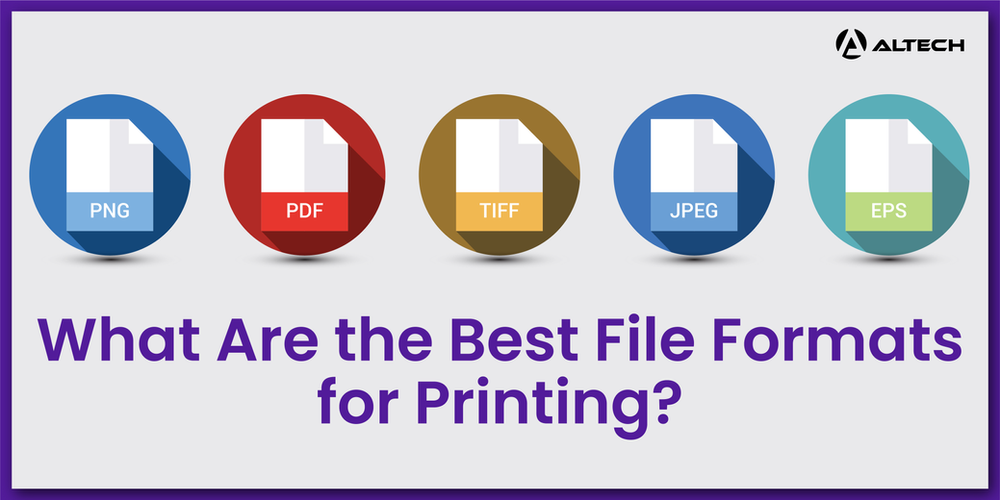
Printing is a crucial process that can either make or break the presentation of your design or photos. The file format you utilize for printing could significantly influence the final output’s quality. Therefore, it is essential to understand the various printing file formats and their respective strengths and weaknesses. The optimal choice ultimately depends on your specific project requirements.
In this comprehensive guide, we will delve into the critical aspects of different file formats, including TIFF, PNG, PDF, JPEG, and EPS, and determine the best one for printing tasks.
Exploring the Best File Formats for Printing
1. TIFF
Tagged Image File Format (TIFF) is a popular choice for a variety of printing tasks, especially photographs. TIFF files offer lossless compression, ensuring image integrity and clarity, making it an ideal format for high-resolution images. However, due to their high resolution, TIFF files can be considerably large, which might pose an issue for storage or transfer.
2. PNG
Portable Network Graphics (PNG) is a lossless file format similar to TIFF, known for its high-quality images. One of the distinguishing features of PNG files is their support for transparency, which can be incredibly useful in certain printing tasks. However, PNG files are usually in the RGB color mode, which is not ideal for CMYK printing.
3.PDF
Portable Document Format (PDF) is one of the most commonly used file formats for printing. PDF files are easy to share and view across different platforms, making them an ideal choice for sharing print-ready files. However, editing PDF files can be a bit challenging, and you might need to convert them to another format for editing.
4. JPEG
Joint Photographic Experts Group (JPEG) is a widely recognized and used file format. Although it uses lossy compression, leading to some loss in image quality, JPEGs offer the advantage of smaller file sizes. This compression makes JPEGs ideal for sharing and transferring, but it’s essential to check the image’s pixel dimensions before printing.
5. EPS
Encapsulated PostScript (EPS) files are an excellent choice for printing vector-based illustrations. EPS files are scalable without losing resolution, making them ideal for print tasks involving logo designs and illustrations. However, EPS files require specialized software for access and editing.
Considering Software Compatibility for Printing
The compatibility of your file format with your design software can be a crucial factor in determining the best file format for printing. Software like Adobe Photoshop, Illustrator, and InDesign, CorelDRAW, and others, all have their preferred file formats for optimal performance and output.
Analyzing the Impact of Color Modes on Printing
The color mode of a file can significantly impact printing outcomes. The two main color modes are RGB (Red, Green, Blue) and CMYK (Cyan, Magenta, Yellow, Key/Black). While RGB is suitable for digital displays, CMYK is more suitable for printing tasks.
Understanding the Role of File Size in Printing
File size can have a significant impact on printing, especially when it comes to large-scale prints. Larger files typically offer higher resolution and better print quality, but they might be more challenging to transfer or share due to their size.
Exploring the Role of Compression in Printing
Compression can influence the quality of printed images. While lossless compression (as in TIFF or PNG) maintains image quality, lossy compression (as in JPEG) can result in a loss of image quality. It’s essential to balance file size and quality when choosing a file format for printing.
Considering the Print Medium for File Format Selection
The type of medium you’re printing on can also influence the best file format choice. For instance, printing on glossy photo paper might require a different file format compared to printing on canvas or fabric.
Recognizing the Importance of Image Resolution in Printing
Image resolution, usually measured in dots per inch (DPI), is a crucial factor in printing. Higher resolution images typically result in better print quality. Therefore, it’s essential to ensure that your chosen file format supports the necessary resolution for your print task.
Ensuring Compatibility with Printers
Finally, it’s crucial to ensure that your chosen file format is compatible with the printer you’re using. While most modern printers support a wide range of file formats, it’s always a good idea to double-check.
Conclusion
Choosing the right file format for printing can significantly impact the quality of your prints. Whether you’re printing photos, designs, or text, understanding the strengths and weaknesses of different file formats can ensure that you choose the best one for your task. Ultimately, the best file format for printing depends on your specific project requirements, the print medium, the printer, and the software you’re using.
By considering these factors and understanding the characteristics of each file format, you can make informed decisions that lead to high-quality prints.
For a free consultation contact us at https://wa.me/971569981942 or call us at +971 56 998 1942
